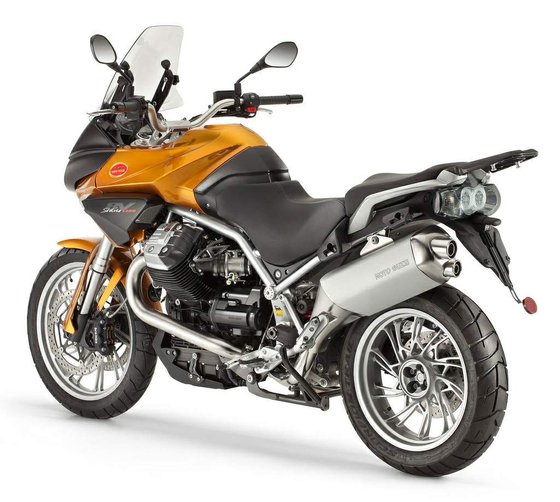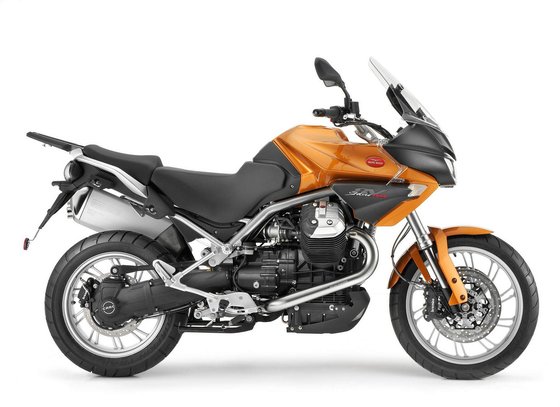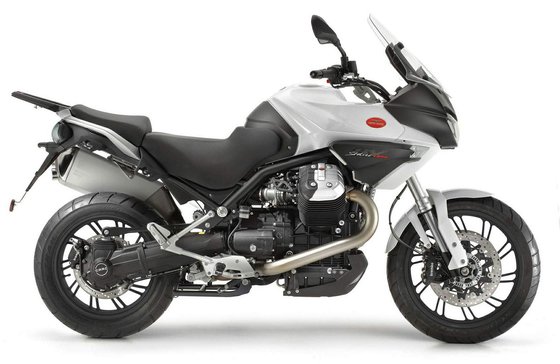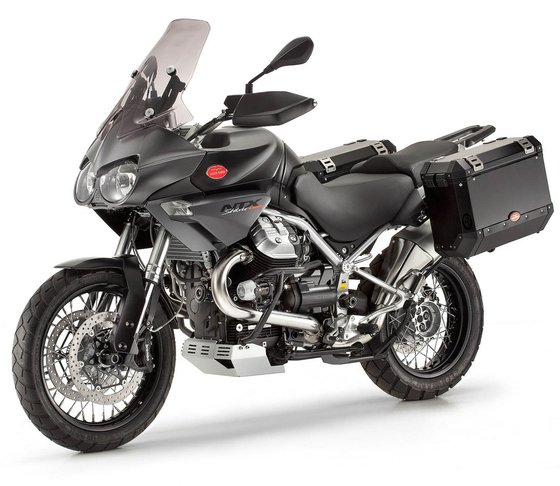Moto Guzzi Stelvio 1200 [2011–2016]: A Timeless Italian Adventurer

Introduction
The Moto Guzzi Stelvio 1200, produced from 2011 to 2016, is a motorcycle that defies convention. Named after the iconic Stelvio Pass in the Italian Alps—a serpentine road with 84 hairpin bends—this maxi-enduro embodies the spirit of exploration with a distinctly Italian flair. Built around Guzzi’s legendary transverse V-twin engine and paired with rugged, long-distance practicality, the Stelvio carved its niche in the adventure-touring segment. This review captures the essence of owning and riding this charismatic machine, blending retro charm with modern functionality.
Design & Aesthetics
The Stelvio’s design is an exercise in purposeful elegance. Its angular bodywork, dominated by a twin-headlight fairing and muscular fuel tank, exudes a no-nonsense adventure aesthetic. The 32-liter (8.45-gallon) fuel tank—a standout feature—integrates seamlessly into the fairing, creating a streamlined profile while offering a staggering range of over 400 km (250 miles). The manually adjustable windshield provides ample wind protection, though taller riders might crave an aftermarket upgrade for cross-country comfort.
Color options ranged from understated Guzzi Black and Lunar White to bold Sienna Orange and Dark Green, with the NTX variant adding satin-finish armor-like crash bars and handguards. Tubeless spoked wheels (standard on the NTX) and aluminum panniers reinforced its go-anywhere intent.

Engine & Performance
At the heart of the Stelvio lies the 1,151cc 90° V-twin, air-cooled and oil-assisted. This “Quattrovalvole” (four-valve) engine delivers 105 HP at 7,250 RPM and a robust 113 Nm (83.3 lb-ft) of torque at 5,800 RPM, with a character that’s unmistakably Moto Guzzi. The longitudinal crankshaft creates a gentle rocking sensation at idle, a quirk that dissolves into smooth power delivery once underway.
The engine thrives in the mid-range, pulling strongly from 3,000 RPM. While it won’t win drag races against modern liquid-cooled rivals, the torque-rich nature makes overtaking effortless. The shaft-driven final drive (via Guzzi’s CA.R.C. system) eliminates chain maintenance and adds refinement, though it introduces mild driveline lash during abrupt throttle changes.
Fuel injection, managed by Magneti Marelli’s IAW5A system, ensures crisp throttle response. Later models (2013 onward) included ATC traction control, a welcome aid for slippery terrain. The six-speed gearbox is precise, though the clutch lever demands a firm pull in stop-and-go traffic.
On-Road & Off-Road Handling
The Stelvio’s chassis is a study in balance. The steel twin-cradle frame, with a 27° rake and 1535 mm (60.4-inch) wheelbase, prioritizes stability without sacrificing agility. Fully adjustable suspension—45mm Marzocchi USD forks (170mm travel) and a Sachs rear monoshock (155mm travel)—absorbs bumps gracefully, whether navigating potholes or gravel trails.
At 272 kg (599 lbs) wet, the NTX variant feels substantial, but weight distribution is intuitive. The 820–840 mm (32.3–33.1-inch) seat height is manageable for taller riders, though shorter pilots might opt for a lowered gel seat. On twisty tarmac, the Stelvio leans confidently, aided by Metzeler Tourance or Pirelli Scorpion Trail tires (110/80-R19 front, 150/70-R17 rear). Off-road, the 210 mm (8.3-inch) ground clearance and crash protection let it tackle moderate trails, though its weight limits extreme dirt excursions.
Brembo brakes—dual 320mm front discs with radial calipers and a 282mm rear—deliver strong stopping power. ABS (standard post-2012) is non-intrusive and can be disabled for off-road use.

Comfort & Ergonomics
The Stelvio shines as a mile-devouring tourer. The upright riding position, wide handlebars, and plush seat create a cockpit designed for all-day comfort. Passenger accommodations are generous, with integrated grab rails and optional top cases.
The 32-liter fuel tank narrows at the knees, improving ergonomics, while the adjustable windshield (manual on base models, optional electric on later variants) reduces fatigue. Heated grips (optional) and a 12V outlet add practicality. The instrument cluster, while dated by modern standards, provides essential data: fuel level, trip computer, and ATC/ABS status.
Technology & Features
Though not a tech powerhouse, the Stelvio offers thoughtful touches:
- ATC Traction Control (2013+): Manages rear-wheel slip without dulling throttle response.
- Continental ABS: Disengageable for off-road riding.
- Onboard Diagnostics: Accessible via the dashboard.
- Modular Luggage System: Aluminum panniers (NTX) and optional top cases.
The lack of ride modes or TFT displays keeps the focus on analog riding joy—a trait purists will appreciate.
Competition
The Stelvio’s contemporaries included:
- BMW R1200GS (2011–2016):
- Pros: Lighter (238 kg / 525 lbs), telelever suspension, superior aftermarket support.
- Cons: Ubiquitous design, higher maintenance costs (boxer engine).
-
Verdict: The GS is the segment benchmark, but lacks the Stelvio’s character.
-
Triumph Tiger 1200 XC (2012–2015):
- Pros: 1215cc triple-cylinder smoothness, advanced electronics.
- Cons: Chain drive, less torque at low RPM.
-
Verdict: A tech-forward alternative, but less soulful.
-
Ducati Multistrada 1200 (2010–2015):
- Pros: 150 HP Testastretta engine, semi-active suspension.
- Cons: Premium pricing, frenetic engine character.
- Verdict: The Multistrada excels on pavement but struggles off-road.
Stelvio’s Edge: Shaft drive reliability, distinctive V-twin personality, and long-range fuel capacity.
Maintenance
The Stelvio rewards diligent owners. Key considerations:
1. Valve Adjustments: Required every 20,000 km (12,400 miles). OHV design simplifies access.
2. Shaft Drive: Inspect seals and lubricate splines annually. CA.R.C. system reduces maintenance vs. traditional shaft drives.
3. Oil Changes: Use SAE 10W-60 (3.5L with filter). The oil-cooled engine runs hot; monitor levels on long trips.
4. Suspension: Rebuild forks/shock every 40,000 km (24,800 miles). Upgrade springs for heavy touring loads.
5. Brake Fluid: Flush with DOT 5.1 every two years.
Common upgrades include aftermarket exhausts (to unleash the V-twin growl) and LED lighting. MOTOPARTS.store offers OEM-spec filters, gaskets, and performance accessories to keep your Stelvio thriving.

Conclusion
The Moto Guzzi Stelvio 1200 isn’t just a motorcycle—it’s an experience. Its quirks (the sideways engine pulse, shaft-driven heft) fade against a backdrop of relentless torque, rugged charm, and continent-crossing capability. While later models like the BMW R1250GS dominate sales charts, the Stelvio remains a cult classic for riders valuing authenticity over trends.
Whether carving Alpine passes or exploring backroads, the Stelvio proves that adventure isn’t about specs—it’s about soul. And in that department, this Italian icon delivers in spades.




Specifications sheet
| Engine | |
|---|---|
| Stroke: | Four-stroke |
| Max power: | 77 kW | 103.0 hp |
| Max torque: | 113 Nm |
| Fuel system: | Multipoint sequential electronic injection, Magneti Marelli IAW5A phased, alfa-n system; two Ø 50mm throttle bodies, Weber IWP 189 injectors, lambda probe |
| Max power @: | 7250 rpm |
| Displacement: | 1151 ccm |
| Max torque @: | 5800 rpm |
| Bore x stroke: | 95.0 x 81.2 mm (3.7 x 3.2 in) |
| Configuration: | V |
| Cooling system: | Oil & air |
| Compression ratio: | 11.0:1 |
| Number of cylinders: | 2 |
| Valves per cylinder: | 4 |
| Dimensions | |
|---|---|
| Wheelbase: | 1535 mm (60.4 in) |
| Dry weight: | 259 |
| Wet weight: | 272 |
| Seat height: | 820-840 mm (32.3-33.1 in) adjustable |
| Overall width: | 1050 mm (41.3 in) |
| Overall height: | 1480 mm (58.3 in) |
| Overall length: | 2250 mm (88.6 in) |
| Ground clearance: | 210 mm (8.3 in) |
| Fuel tank capacity: | 32 L (8.5 US gal) |
| Drivetrain | |
|---|---|
| Clutch: | Single-disc with integrated anti-vibration buffer |
| Final drive: | shaft |
| Gear ratios: | 1st 2.235, 2nd 1.700, 3rd 1.348, 4th 1.115, 5th 0.968, 6th 0.862 |
| Transmission: | 6-speed |
| Maintenance | |
|---|---|
| Rear tire: | 180/55-17 (150/70-17 on ntx models) |
| Engine oil: | 10W60 |
| Front tire: | 110/80-19 |
| Brake fluid: | DOT 5.1 |
| Gearbox oil: | 500 ml SAE 80W-90 |
| Spark plugs: | NGK CR8EKB |
| Spark plug gap: | 0.7 |
| Final drive oil: | 380 ml SAE 85W-90 |
| Engine oil capacity: | 3.5 |
| Engine oil change interval: | Every 5000 km or 2 years |
| Valve clearance (intake, cold): | 0.10–0.20 mm |
| Valve clearance check interval: | 24,000 km / 15,000 mi |
| Valve clearance (exhaust, cold): | 0.20–0.30 mm |
| Recommended tire pressure (rear): | 2.5 bar (36 psi) |
| Recommended tire pressure (front): | 2.25 bar (33 psi) |
| Additional Features | |
|---|---|
| ABS: | Standard on most models |
| Luggage: | Hard saddle bags (NTX models) |
| Handguards: | Standard on NTX |
| Windshield: | Adjustable height |
| Traction control: | ATC system (deactivatable) |
| Chassis and Suspension | |
|---|---|
| Frame: | High tensile steel tubular twin cradle |
| Trail: | 125 mm (4.9 in) |
| Rear brakes: | Single 282 mm disc, 2-piston caliper (ABS) |
| Front brakes: | Dual 320 mm discs, 4-piston radial calipers (ABS) |
| Rear suspension: | Progressive linkage monoshock (adjustable preload, rebound damping) |
| Front suspension: | 45-50 mm USD adjustable forks (spring preload, compression, rebound damping) |
| Rake (fork angle): | 27.0° |
| Rear wheel travel: | 155 mm (6.1 in) |
| Front wheel travel: | 170 mm (6.7 in) |



















